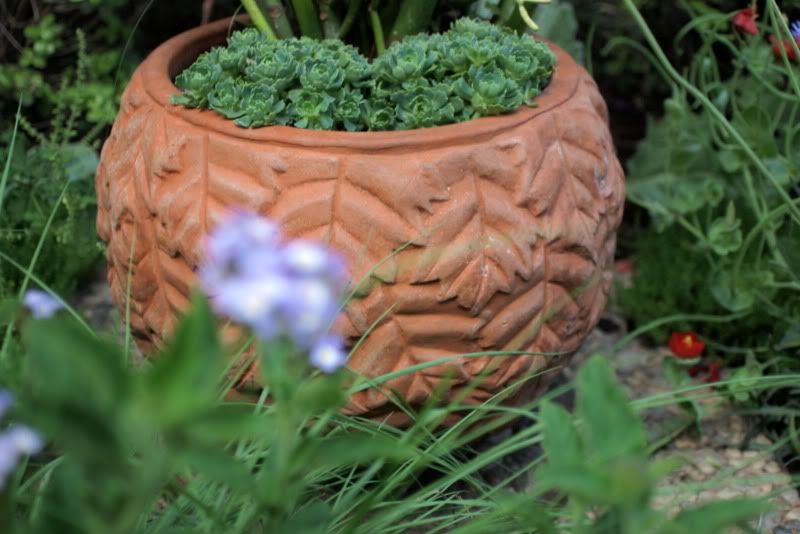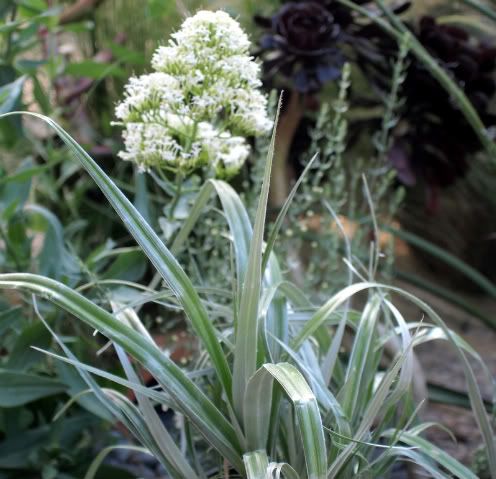…and come home with an astelia.
Hostas intrigue me because, in Zone 10 gardening manuals, they can reliably be found under the entry “When Pigs Can Fly.” Yet there’s always a few for sale at nurseries in spring, usually some unhappy-looking, decrepit specimens, no doubt unhappy because they know they’re soon to be sacrificed on the altar of some transplanted Easterner’s nostalgic case of raging zonal denial. Now, I’m a native zone-10-er, and I try to make a garden that revels in its zone. But it hasn’t escaped my notice that everyone seems to be growing and attempting to overwinter zone 10 plants, so why not the reverse in zone 10? Tender perennials are grown as annuals out of their hardiness range, so why not cold-hardy perennials grown as annuals in zone 10? I’m not interested in the hosta’s flowers, which a young plant may or may not produce, just the leaves. Over the mild winter, the hosta will succumb to sleep deprivation, when their required dormancy fails to initiate. Whatever else a garden may be, and I’ll probably die with that question on my lips like Charles Foster Kane, it is to begin with an artificial construct.
I’ve been mulling this over and thinking that trying out a single hosta in a pot this summer might be an interesting experiment. In terms of waste, most tulips are grown as annuals, are they not? And the hosta can feed the compost pile over the winter. If the potted hosta sat in a saucer of water in light shade, it just might be deceived into believing it was back home somewhere in Japan. And I’d have a summer’s worth of gazing into those exotic, pleated leaves. What a deal.
And just this week, Margaret Roach, on her blog A Way To Garden, revealed that she prefers her hostas potted. That was all the incentive needed. (Thank you, Margaret!)
I did indeed find hostas at a neighborhood nursery just a few blocks away, and they were indeed miserable specimens. I had to check the label for variety, because all variegation or blueness to leaf had bleached out in the full-sun treatment they were being given. I grabbed the best-looking sieboldiana they had, then made a perfunctory check of the nursery before heading to the cash register.
Oh, my. The succulent section had lots of new arrivals. Hard to believe, but local nurseries are just now catching on that succulent mania has swept the nation. Bit of a cognitive delay. But now the rare stuff is finally trickling in. I steered clear of the expensive stuff, but what nice sedums they had! This one, labeled ‘Blue Mini Rosette,’ most likely S. pachyclados, resembling a saxifrage, obligingly filled a gaping hole in a pot of Sticks on Fire. (In a small garden, any expanse of soil over 3 inches is considered gaping.)
Might as well check out the shrubs too. What’s that glinting silvery in the mid-afternoon sun? Oh, sure, the expensive astelias. What? You say you’re in a gallon? Lordy, let’s go!
In its gallon size, the astelia was a couple bucks more than the hosta. Bye-bye hosta. I still think it’s a worthy experiment, but I’ll take reveling in my zone versus a lab experiment any day. I completely understand the experimentation by those in colder zones, with temps slipping and sliding all over the map, and where would horticulture be without the yearning for the foreign and strange?




Well I’m going to go right out and give all of my hostas a big hug! I really appreciate you highlighting something we can grow up here in Oregon and ya’ll in Cali (or southern at least) theoretically cannot. Although I really think you should experiment. After all I’ve discovered that I can grow Astelia as long as I keep them in a pot where they can be protected when things get really winterish.
As a zone-8-er, you’ve given me a renewed appreciation for our zonal highlights, hostas definitely among them. Having just added a couple more this year (courtesy of a neighbor, so no cultivar names), I can say the summer front garden is looking decidedly Northwest. I guess in your neck of the woods, neighbors exchange agaves, right?
I added S. pachyclados last year and it made it through our harsh winter. Sedums may be one thing we have in common, zonally speaking. Yours looks great in that terracotta pot.
Are you guys kidding? Hostas are very cool, though a monoculture of them would be dull. I’m hoping to find a semi-shady spot in the ground for the astelia.
Jane, I bet we all have sedums in common. I could go seriously nuts over sedums.
Denise,my excitement at having the chill hours and rain events that would facilitate Hosta growth when I moved North was soon deflated. Snails. Snails snails snails. Bloody snails, eff-ing snails, damnable snails. Hostas look really bad when they are just leaf veins. But maybe in a pot ? Can I take the mental anguish ?
Kathy
There were some pristine, healthy Hostas a few weeks ago at Green Thumb in El Toro.
Astelia banksii, I’ve killed that one. A lovely plant.
Kathy, I’m surprised the snails chased you away from hostas. Must be some bad-a** snails.
Hoov, that’s quite a tally you’ve got going. Me too. I’m thinking your NZ advice for the astelia, afternoon shade, is requisite.